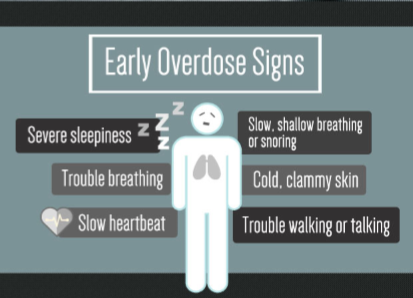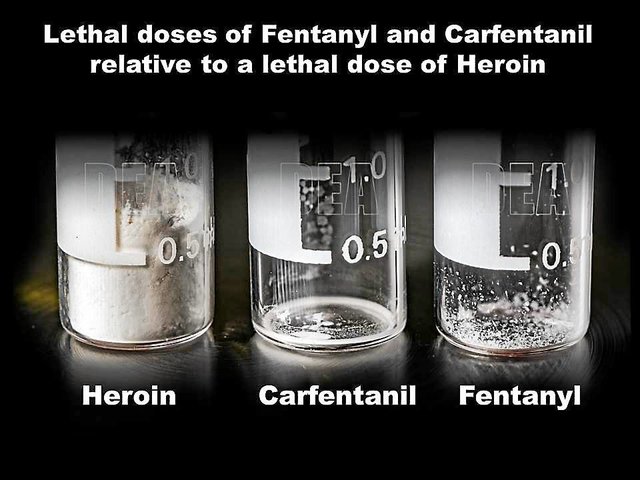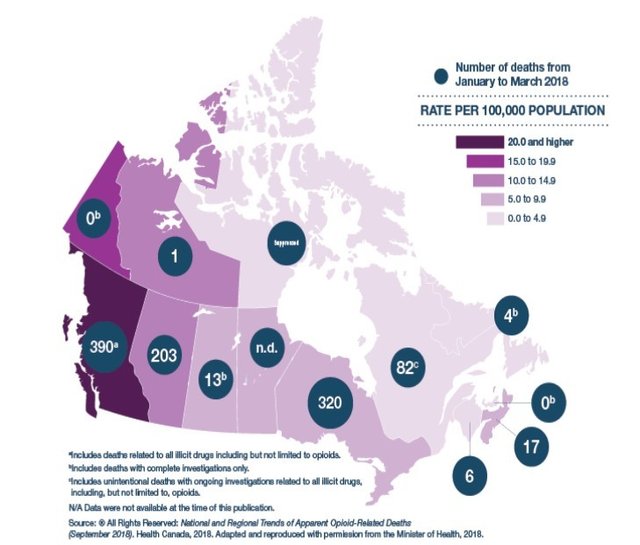|
|
|
| |
| |
|
Secondary Opioids and Fentanyl February 2020
|
![Secondary Opioids and Fentanyl February 2020]() |
|
|
|
|
|
 | February 2020
Secondary Snapshot
Opioids and Fentanyl
|
|
|
|
|
Opioids are depressant drugs with pain relieving properties. Opioids can also induce euphoria, which gives them the potential to be used recreationally.
The most common Opioids are: codeine, fentanyl, morphine, oxycodone, hydromorphone, and heroin.
Short term side effects include: drowsiness, nausea and vomiting, euphoria, difficulty breathing, headaches, and/or overdose.
Long term side effects can include: increased tolerance, dependence, liver damage, worsening pain, withdrawal symptoms, and/or overdose.
|
|
|

|
WHAT IS AN OPIOID OVERDOSE?
Opioid overdoses can occur when an individual consumes more opioids than the body can handle.
Symptoms of an overdose may include:
- being non responsive
- slow or stopped breathing
- choking or gurgling sounds
- blue lips or nails
- cold or clammy skin
- tiny pupils
|
|
|
Overdose risk increases when:
- Tolerance is lowered (after a period of non-use, or first time users)
- An individual has been sick, dehydrated or has liver issues
- Substances are mixed
- Substances are stronger than the body is used to | The consequences of an overdose may be short term, particularly if lifesaving interventions such as Naloxone are used quickly for support, but there is also the possibility for long term brain damage or death.
|
|
|
|
|

|
Fentanyl is an extremely potent synthetic opioid that can be prescribed for the treatment of acute and chronic pain, and it is approximately 100 times more potent than morphine, and 20 - 50 times more potent than heroin.
Legal fentanyl comes most commonly in a patch and liquid form and is administered in a hospital setting.
|
|
|
Illicit Fentanyl is a white, crystallized powder substance with no distinct odour. This powder is mixed with other drugs (i.e. heroin) to increase its potency, sold in its powder form, or pressed into counterfeit pills resembling various medications like Oxycontin, Percocet or Xanax
|
|
|
|
What is Carfentinil? Carfentanil is a synthetic opioid normally used as a sedative for large animals such as elephants. It is an analogue of fentanyl and can be 100 times more toxic than fentanyl. It looks similar to table salt - ingesting one or two grains can be fatal to humans.
|
| |
|
|
|
From January 2016 to October 2016 there were 683 apparent illicit drug overdose deaths, which was a 60.9% increase from the same time period in 2015. The province declared a public health emergency in April 2016. In the same time period for 2017, there were 1208 deaths in BC. The total number of deaths from illicit drug overdoses now eclipses any other unnatural cause of death in BC, including suicide and motor vehicle incidents.
Vancouver has the highest death rate, followed by the Okanagan area, Fraser East, and then Central Vancouver Island. The majority of deaths are caused by opioids such as fentanyl, heroin, morphine, and oxycodone often combined with other drugs and alcohol; most deaths occur in private residences.
|
|
|
 | The Canadian Centre on Substance Use and Addiction states that the following factors have contributed to the current crisis:
* A misunderstanding of the addictive risk of prescription opioids
* Frequent opioid prescribing and high amounts being prescribed for pain relief
* Lack of awareness of alternative treatments for pain
* Theft of prescription opioids by friends and family members
* Lack of access to prescription opioids leading to illicit opioid use
* Illegal drugs that are laced with other substance, such as fentanyl
* Psychological, social and biological risk factors like genetics, mental health, trauma, poverty and other social determinants of health
* Stigma towards substance use disorders, discouraging individuals from seeking help
|
|
|
|
|
| HARM REDUCTION STRATEGIES IN RELATION TO OPIOIDS
|
|
|
Research shows that harm reduction activities do not encourage substance use; in fact they are more likely than other methods to encourage people who use substances to start treatment.
In Greater Victoria School District, we view harm reduction as a continuum with the safest harm reduction strategy being Avoidance moving to the concept ..
|
of Delaying use, and at the other end of the continuum, Reducing use. All students should attempt to reduce, delay or preferably avoid opioids, as there is the very real risk of overdose with each use.
Other harm reduction strategies can include:
* only using with others
* carrying Naloxone if around any potential opioid users
|
* using safe injection sites
* discussing options with a ...physician or substance use ...counsellor
* testing substances
* further education and ..conversations about potential ..risks.
It is important to remember that addiction is a complex illness with many contributing factors and no easy solutions.
|
|
|
|
|
|
Adolescents, like other groups, may use opioids for a variety of reasons.
Some people use opioids for pain treatment or for temporary relief from anxiety, adverse experiences or difficult life circumstances.
Others use opioids to experience a feeling of euphoria or out of curiosity about drugs that are perceived as risky or out the mainstream; conversely, others may be using because it is accepted in their peer group.
Some users unintentionally expose themselves to opioids mixed into another type of drug they buy from an unregulated supplier. |
Strategies for talking to youth about Opioids:1. Educate yourself so you can answer questions
2. Become informed about substances commonly used by young people
Click here for June 2019 Snapshot on Illicit Drugs
3. Be a good listener
4. Stick to the facts - avoid scare tactics and exaggeration
5. Focus on heart felt concerns
6. Discuss the concepts of harm reduction: avoid, delay and reduce
|
| |
|
|
|
|
|
|
|
|
|
|

| GENERAL HARM REDUCTION STRATEGIES
1. Avoid, Delay, Reduce Use
2. Don’t Use Alone
3. Carry Naloxone, if around
Opioids:
Toward the Heart
|
| |
|
|
|
The Greater Victoria School District is committed to providing safe and healthy learning environments for all students. As part of our approach, we have been focusing on mental health and substance use topics to help us promote well-being in our schools.
Substance use is a complex topic that often highlights varied philosophies, myths, and a great deal of fear.
|
The research shows us that early interventions, particularly around critical thinking and decision making, has an impact on delaying use in youth. As well, open dialogue with adults, intentionality around attachment, and a focus on the factors that contribute to substance use, as opposed to the actual substances, also prevent, delay and reduce substance use in our students.
|
Our goal is to create a more cohesive, systematized substance use plan focusing on social emotional learning, that includes our youth and schools, community partners, and families. We strive for a shared vision, common language and consistent messaging over time, in order to support positive youth culture and a healthy perspective on substance use and mental health.
|
|
|
|
|
| |
|
|
|
|
|
|
|
|
| |
|